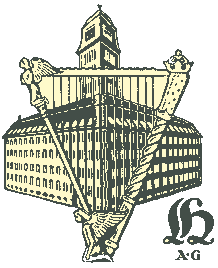|
| |
Hupfeld Helios and Phonoliszt-Violina
Automatic Musical Instrument
|
Back |
| |
A Brief Look at the History of Hupfeld
Hupfeld grew to become the world's largest distributor and manufacturer of "self-playing" automatic musical instruments, eventually producing a wide variety of disc, pinned-barrel and music roll operated music machines in its own immense factories. Some of the automated orchestras crafted were spectacularly large and very complex devices. While other contemporary large and well known manufacturers of "automatics," such as the Regina Music Box Company, Seeburg or Wurlitzer, could boast an employee count well into the hundreds, Hupfeld, in sharp contrast, had a contingent of employees numbering in the thousands.
However, the company of Ludwig Hupfeld, A.G., at one time famous for its stunning array of finely built products, did not start out big, nor even with the Hupfeld name. Sometime around 1880 to 1882 a fellow by the name of J.M. Grob, along with two partners, founded J.M. Grob & Company, opening a small "art shop" in Leipzig-Eutritzsch, Germany.
|
 |
| |
The new company sold various mechanical musical instruments, such as disc music boxes and small hand-cranked organettes, but soon began manufacturing its own stable of mechanical instruments, which were marketed in the company's shop, alongside products from other companies. By 1886 an attachment for automatically playing pianos and organs, using paper tune-sheets, had been perfected. Other advantageous refinements to the automatic player action quickly followed, with the ingenious Grob player action being licensed to other manufacturers for incorporation into their own products.
In time Grob & Company acquired the distributorship of many prominent musical instrument manufacturers in the Leipzig area, making Grob a well known entity for both sales and mechanical music innovation. Then, in 1892, Ludwig Hupfeld took over the company, changing the name to Hupfeld Musikwerke, although the Grob name was still used in advertising up until about 1900. Push-up players and pianos with pneumatic mechanisms and music roll systems located under the keyboard were added to the line. As sales and production soared the company enlarged its manufacturing facilities many times, but, with each expansion, it quickly outgrew the newly added space. In 1904, to meet the financial demands necessary to maintain and further expand their manufacturing requirements, the company was incorporated under the name Ludwig Hupfeld A.G.
To keep up with the demand for automatic music, an enormous factory was put under construction in 1909. Finished in 1911, the giant Böhlitz-Ehrenberg factory, with its imposing tower (depicted in the logo above), was opened, becoming the impressive new home for Hupfeld. The new factory measured approximately 1,000,000 square feet in area, and contained several different manufacturing areas, kitchens and dining rooms, washrooms, as well as elaborate social facilities, all under one roof. By 1912 some 1200 employees manned the sparkling new factory, a number that climbed to over 2000 a few years later. Additionally, there were many other Hupfeld employees, too, staffing various branch factories and sales outlets.
By 1925 automatic instrument sales had slumped to a mere trickle, the complicated and often temperamental music machines being replaced by the phonograph and the radio. In 1926, in an effort to stave off the financial problems suffered due to the lack of automatic musical instrument sales, Hupfeld merged with Gebr. Zimmermann, a piano manufacturer, and the name was changed to Leipziger Pianoforte & Phonolafabriken, Hupfeld-Gebrüder Zimmermann A.G. After the merger with Zimmermann most of the branch factories and sales outlets were closed, leaving only the large factory at Böhlitz-Ehrenberg and two small branch factories still at work.
Production of pneumatic automatic musical instruments stopped altogether about 1930, with a little residual stock remaining available for the next few years. Music roll production ceased about 1934. Then, as the Nazi presence expanded into World War II the factory was converted into a manufacturing complex for military goods. This made the old Hupfeld factory a strategic target, the Böhlitz-Ehrenberg building suffering from some bomb damage, with the most heavily damaged areas of the complex being razed instead of being rebuilt. After the war, what remained of the once huge factory was put back into music related manufacturing. But this time it was just ordinary pianos that were to be manufactured, something that continues to this present day, under the new name of VEB Deutsche Piano Union. During and after the war any remaining traces of the glorious days of automatic instrument making were destroyed and forever erased from what remained of the once grand Hupfeld empire.
Although a small number of Hupfeld instruments were distributed in this country, by Ernst Böcker of New York City, for instance, few of these US sold machines exist today. Ironically, the Rudolph Wurlitzer Company, who could have made the Hupfeld instruments famous in the United States, and who wanted to do so, was not able to arrange a distributorship with Hupfeld. Farny Wurlitzer, one of Rudolph Wurlitzer's three sons, first learned about Hupfeld machines while attending the 1902 Leipzig trade-fair during a visit to Germany. Farny approached the Hupfeld management regarding a distributorship in America. The proposal might have come to pass, except for the Wurlitzer's insistence that Farny be allowed to work in the Hupfeld factory for six months to learn all about the construction, care and maintenance of the various machines. Hupfeld was reluctant to allow this, probably assuming Farny would steal their trade secrets, and sent the Wurlitzers to the J.D. Philipps Musikwerke in Frankfurt, Germany,
advising them that maybe Philipps would accommodate them.
Philipps eventually agreed to the terms of the Wurlitzer management, and the large Philipps Pianella cabinet style orchestrions became known in America as The PianOrchestra, with the later Paganini type Pianella instruments being known as Paganini Violin Players and Orchestrions.
|
|
|
|

